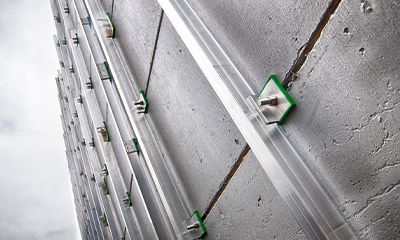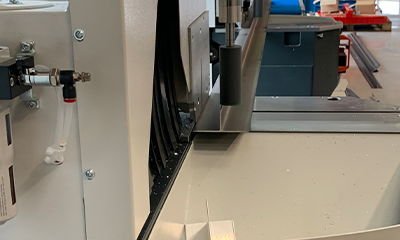U-values adjustment to rainscreen subframes
How are U-values adjusted to account for rainscreen subframes?
Written by David Fraser, Rainscreen System - Business Unit Manager in SFS Group Fastening Technology Ltd.
Thermal transmittances, or U-values, calculated for external walls with a rainscreen facade must be corrected in accordance with BRE Report (BR) 443, to take account of the thermal bridging effect of the rainscreen subframe system.
A separate blog post looks at how most U-values are calculated using the combined method, which is a simplified form of calculation. This post considers how the combined method is not sophisticated enough to account for the complex heat transfer through a subframe’s helping hand brackets, and what options are available instead to ensure accurate heat loss calculations.
Why are corrections for rainscreen subframe brackets different?
BS EN ISO 6946, the international standard that describes the combined method for calculating U-values, includes a correction for simple fixings that penetrate an insulation layer.
The fixings should be regularly spaced, in order to allow an accurate ‘per m2’ rate to be entered. They should also be a consistent size and have consistent thermal properties, the details of which can both be entered in order to establish how the uncorrected U-value needs to be adjusted.
A significant benefit of this correction method is that the information tends to be readily available from fixing manufacturers. Therefore, no complex thermal modelling calculations need to be carried out to work out a point thermal transmittance (chi value) for the fixing.
The fixings should be regularly spaced, in order to allow an accurate ‘per m2’ rate to be entered. They should also be a consistent size and have consistent thermal properties, the details of which can both be entered in order to establish how the uncorrected U-value needs to be adjusted.
A significant benefit of this correction method is that the information tends to be readily available from fixing manufacturers. Therefore, no complex thermal modelling calculations need to be carried out to work out a point thermal transmittance (chi value) for the fixing.

However, the complexity of helping hand brackets is such that their effect on the U-value is much larger than a simple fixing. The U-value must therefore be adjusted in other ways.
How does BR 443 adjust U-value calculations for rainscreen subframes?
BR 443 is a document describing industry conventions that should be used when calculating U-values. At the time of writing, the most recent version is the 2019 edition. Any construction professional who frequently works with U-values should have an understanding of BR 443.
It offers three routes by which a rainscreen subframe can be accounted for. The first is to carry out a detailed calculation for the complete wall build-up, thereby not using the combined method at all.
It offers three routes by which a rainscreen subframe can be accounted for. The first is to carry out a detailed calculation for the complete wall build-up, thereby not using the combined method at all.
An alternative is to calculate a point thermal transmittance for any fixing bracket that penetrates an insulation layer (or a linear thermal transmittance for a fixing rail). This means the thermal performance of the bracket is modelled using a detailed calculation procedure, and its effect applied to a combined method calculation for the rest of the wall.
The final option is to calculate the U-value of the wall without any account of the fixings, and apply a default correction as given in the standard. The default correction heavily penalises the final U-value result and is not feasible for projects where low U-values need to be achieved.
It is clear, therefore, that some form of detailed calculation is required to ensure that a subframe’s impact on the external wall’s thermal performance is accounted for accurately. The subframe and insulation specification can then be optimised to deliver the most cost-effective solution without over-specifying bracket sizes and insulation thicknesses.
SFS are NOT thermal engineers, however we can make recommendations based on the point loss (chi value) of our subframe bracket systems.
SFS’s Project Builder tool provides tailored solutions for rainscreen facade projects, including point thermal transmittances for helping hand brackets. It helps specifiers to find the optimal thermal solution to meet a project’s U-value requirements.
The final option is to calculate the U-value of the wall without any account of the fixings, and apply a default correction as given in the standard. The default correction heavily penalises the final U-value result and is not feasible for projects where low U-values need to be achieved.
It is clear, therefore, that some form of detailed calculation is required to ensure that a subframe’s impact on the external wall’s thermal performance is accounted for accurately. The subframe and insulation specification can then be optimised to deliver the most cost-effective solution without over-specifying bracket sizes and insulation thicknesses.
SFS are NOT thermal engineers, however we can make recommendations based on the point loss (chi value) of our subframe bracket systems.
SFS’s Project Builder tool provides tailored solutions for rainscreen facade projects, including point thermal transmittances for helping hand brackets. It helps specifiers to find the optimal thermal solution to meet a project’s U-value requirements.

 English (Canada)
English (Canada)
 čeština (Česká republika)
čeština (Česká republika)
 magyar (Magyarország)
magyar (Magyarország)
 Deutsch (Deutschland)
Deutsch (Deutschland)
 eesti (Eesti)
eesti (Eesti)
 español (España)
español (España)
 português (Portugal)
português (Portugal)
 English
English
 suomi (Suomi)
suomi (Suomi)
 français (France)
français (France)
 italiano (Italia)
italiano (Italia)
 Nederlands (Nederland)
Nederlands (Nederland)
 norsk, bokmål (Norge)
norsk, bokmål (Norge)
 polski (Polska)
polski (Polska)
 svenska (Sverige)
svenska (Sverige)
 Türkçe (Türkiye)
Türkçe (Türkiye)






